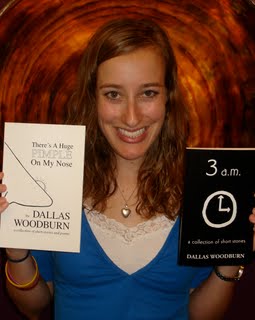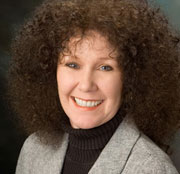Friday Speak Out!: "From Almost Famous . . . To the Cutting-room Floor," Guest Post by Dallas Nicole Woodburn
FROM ALMOST FAMOUS . . . TO THE CUTTING-ROOM FLOOR
by Dallas Nicole Woodburn
Soon, my face will be on that big screen, I thought, as the plush theater seats steadily filled around me for the red-carpet premiere. I’ll be famous!
Okay, almost famous. Or, maybe, recognizable. Possibly. Around campus.
“Why are you here, dear?” asked the Versace-dressed woman beside me in the center-aisle VIP second-row seats.
I tried, but failed, to hide my smile. “I’m in The Movie,” I said, excitement overwhelming any small dose of humility I possessed.
Okay, so maybe movie isn’t the right word. It was more of a short film; a documentary to celebrate the 125th anniversary of the University of Southern California, where I was a freshman majoring in Creative Writing. As a student with two published books to my name (first editions still available!) they interviewed me twice, for more than an hour each time, asking all sorts of questions: Why did you choose USC? Do you like the writing program? If you see Pete Carroll, will you get his autograph for me?
I spoke about the energy and school spirit on campus, how President Sample (who had come across my second book) wrote me a personal letter welcoming me to the university, and I mentioned I was looking forward to having T.C. Boyle, one of my favorite authors, as a professor in upcoming years. I was thoughtful, I was eloquent, I was charming. “You’re a natural,” the cameraman told me.
Now. The lights went down. I patiently fidgeted through each big-screen interview, until suddenly my face appeared, as huge as Dan Brown’s advance check.
“I’m sooooo excited about having T.C. Boyle as a professor!” On-Screen Me gushed.
The camera cut to Professor Boyle, looking as Hollywood as ever in his trademark red Converse high-tops, a suit-jacket over a black T-shirt, and sunglasses hanging from a bead Zen-like necklace. “I think I provide an inspiration for them,” he said. He paused, then added the punchline – and punch to my stomach: “Because they think, if he can do it, anybody can!”
He laughed.
I cringed.
I waited for the film to return to me – this time Calm Me, regaining face with a more poised comment – but soon the closing music swelled, the credits rolled, the lights came up, and it was Over. Finished. My starring role was reduced to a blink-and-you’ll-miss-it line that made me seem like a teeny-bopper with a crush. Meanwhile, my two hours – minus eight seconds – of brilliant interview lay on the digital-age equivalent of the cutting room floor. I might be “a natural,” but I decided, then and there, to stick with screenwriting.
* * *
“If you're writing screenplays, STOP IT!” Ray Bradbury exclaimed, his voice filling the packed auditorium. “Hollywood’s full of $#*&!”
The audience roared, but his words made me shrink. If the great Ray Bradbury has trouble selling scripts, surely I’m full of $#*& for thinking I can.
And yet, here I was nine months later at the Santa Barbara Writers Conference, teaching a workshop for young writers – and also slipping into the highly acclaimed Walter Dallenbach’s screenwriting workshop whenever I got a chance. Here, I joined a group of two-dozen other Hollywood hopefuls to read our screenplays aloud for “flow,” all of us dreaming that our script will become the next Sundance surprise.
“I was walking in downtown L.A. last week,” Walter told us, “and I randomly asked ten people what problem they were having with their screenplay. Of those ten people, only two gave me strange looks and said they weren’t working on a screenplay – the remaining eight of them launched into detailed descriptions of their plot holes and character troubles.” A few people laughed. “I’m not joking,” Walter insisted. “Hollywood’s full of $#*&&% screenwriters!”
* * *
The final night of the Santa Barbara conference, T.C. Boyle – wearing his trademark ensemble of red high-top Converse sneakers and T-shirt/suit jacket – read a sneak snippet from his latest book. Incredibly, the guy still doesn’t know who I am, even aft er I sent him a copy of my book, introduced myself at the L.A. Times Festival of Books, and cornered him in the English department elevator, where I lamely stammered “Y-y-yes” when he asked what floor I wanted.
Even though a number of his novels have been made into feature films, Boyle echoed Bradbury’s comments, saying: “I don’t fool around with screenplays. I sell the rights and let Hollywood deal with it.”
Later, T.C. – who had been introduced by his full name, Thomas Coraghessan Boyle – signed books. I joined the long line of eager fans, hoping he hadn’t yet gotten a restraining order against me for stalking. Fifteen minutes later, I was staring at my nervous reflection in Boyle’s mirrored sunglasses, while he read my name from the sticky-note placed on the book’s title page to speed up the process. “Dallas . . .” he said, the syllables rolling slowly off his tongue, as if perhaps I was indeed vaguely familiar, then noticed my “Young Writers Program Faculty” name-tag. “How were the kids?” he asked, gesturing to it with his pen.
“I had a lit agent talk to them yesterday,” I said, trying to coolly, and finally, make a memorable impression. “He told the class he’s interested in anything – fiction, nonfiction, thrillers, romance. Anything except science fiction or fantasy. Then, he went around the room and asked each kid, one by one, what kind of book they’re working on, and, one by one, they told him, ‘Fantasy. Science fiction. Fantasy. . .’ Nothing but science fiction and fantasy, all twenty-four of them!”
The moment stretched seemingly as long as a Peter Jackson movie, and then . . . he laughed. Thomas Coraghessan Boyle laughed.
“You’re a natural,” T.C. said. I beamed, even though I knew the compliment was pure Hollywood: full of $#*&.
* * *
 Dallas Woodburn, 22, is the author of two collections of short stories and a forthcoming novel. Her short fiction has been nominated for the Pushcart Prize and has appeared in the literary magazines Monkeybicycle, Arcadia Journal, Cicada, The Newport Review, and flashquake, among others. She has also written articles for Family Circle, Writer's Digest, Motherwords, and The Los Angeles Times. Find out more about her nonprofit literacy foundation and youth publishing company at www.writeonbooks.org and https://dallaswoodburn.blogspot.com/
Dallas Woodburn, 22, is the author of two collections of short stories and a forthcoming novel. Her short fiction has been nominated for the Pushcart Prize and has appeared in the literary magazines Monkeybicycle, Arcadia Journal, Cicada, The Newport Review, and flashquake, among others. She has also written articles for Family Circle, Writer's Digest, Motherwords, and The Los Angeles Times. Find out more about her nonprofit literacy foundation and youth publishing company at www.writeonbooks.org and https://dallaswoodburn.blogspot.com/
~~~~~~~~~~~~~~~~~~~~~~~~~~~~~~~~~~~~~~~~~~~~
Would you like to participate in Friday "Speak Out!"? Email your short posts (under 500 words) about women and writing to: marcia[at]wow-womenonwriting[dot]com for consideration. We look forward to hearing from you!
~~~~~~~~~~~~~~~~~~~~~~~~~~~~~~~~~~~~~~~~~~~~
by Dallas Nicole Woodburn
Soon, my face will be on that big screen, I thought, as the plush theater seats steadily filled around me for the red-carpet premiere. I’ll be famous!
Okay, almost famous. Or, maybe, recognizable. Possibly. Around campus.
“Why are you here, dear?” asked the Versace-dressed woman beside me in the center-aisle VIP second-row seats.
I tried, but failed, to hide my smile. “I’m in The Movie,” I said, excitement overwhelming any small dose of humility I possessed.
Okay, so maybe movie isn’t the right word. It was more of a short film; a documentary to celebrate the 125th anniversary of the University of Southern California, where I was a freshman majoring in Creative Writing. As a student with two published books to my name (first editions still available!) they interviewed me twice, for more than an hour each time, asking all sorts of questions: Why did you choose USC? Do you like the writing program? If you see Pete Carroll, will you get his autograph for me?
I spoke about the energy and school spirit on campus, how President Sample (who had come across my second book) wrote me a personal letter welcoming me to the university, and I mentioned I was looking forward to having T.C. Boyle, one of my favorite authors, as a professor in upcoming years. I was thoughtful, I was eloquent, I was charming. “You’re a natural,” the cameraman told me.
Now. The lights went down. I patiently fidgeted through each big-screen interview, until suddenly my face appeared, as huge as Dan Brown’s advance check.
“I’m sooooo excited about having T.C. Boyle as a professor!” On-Screen Me gushed.
The camera cut to Professor Boyle, looking as Hollywood as ever in his trademark red Converse high-tops, a suit-jacket over a black T-shirt, and sunglasses hanging from a bead Zen-like necklace. “I think I provide an inspiration for them,” he said. He paused, then added the punchline – and punch to my stomach: “Because they think, if he can do it, anybody can!”
He laughed.
I cringed.
I waited for the film to return to me – this time Calm Me, regaining face with a more poised comment – but soon the closing music swelled, the credits rolled, the lights came up, and it was Over. Finished. My starring role was reduced to a blink-and-you’ll-miss-it line that made me seem like a teeny-bopper with a crush. Meanwhile, my two hours – minus eight seconds – of brilliant interview lay on the digital-age equivalent of the cutting room floor. I might be “a natural,” but I decided, then and there, to stick with screenwriting.
* * *
“If you're writing screenplays, STOP IT!” Ray Bradbury exclaimed, his voice filling the packed auditorium. “Hollywood’s full of $#*&!”
The audience roared, but his words made me shrink. If the great Ray Bradbury has trouble selling scripts, surely I’m full of $#*& for thinking I can.
And yet, here I was nine months later at the Santa Barbara Writers Conference, teaching a workshop for young writers – and also slipping into the highly acclaimed Walter Dallenbach’s screenwriting workshop whenever I got a chance. Here, I joined a group of two-dozen other Hollywood hopefuls to read our screenplays aloud for “flow,” all of us dreaming that our script will become the next Sundance surprise.
“I was walking in downtown L.A. last week,” Walter told us, “and I randomly asked ten people what problem they were having with their screenplay. Of those ten people, only two gave me strange looks and said they weren’t working on a screenplay – the remaining eight of them launched into detailed descriptions of their plot holes and character troubles.” A few people laughed. “I’m not joking,” Walter insisted. “Hollywood’s full of $#*&&% screenwriters!”
* * *
The final night of the Santa Barbara conference, T.C. Boyle – wearing his trademark ensemble of red high-top Converse sneakers and T-shirt/suit jacket – read a sneak snippet from his latest book. Incredibly, the guy still doesn’t know who I am, even aft er I sent him a copy of my book, introduced myself at the L.A. Times Festival of Books, and cornered him in the English department elevator, where I lamely stammered “Y-y-yes” when he asked what floor I wanted.
Even though a number of his novels have been made into feature films, Boyle echoed Bradbury’s comments, saying: “I don’t fool around with screenplays. I sell the rights and let Hollywood deal with it.”
Later, T.C. – who had been introduced by his full name, Thomas Coraghessan Boyle – signed books. I joined the long line of eager fans, hoping he hadn’t yet gotten a restraining order against me for stalking. Fifteen minutes later, I was staring at my nervous reflection in Boyle’s mirrored sunglasses, while he read my name from the sticky-note placed on the book’s title page to speed up the process. “Dallas . . .” he said, the syllables rolling slowly off his tongue, as if perhaps I was indeed vaguely familiar, then noticed my “Young Writers Program Faculty” name-tag. “How were the kids?” he asked, gesturing to it with his pen.
“I had a lit agent talk to them yesterday,” I said, trying to coolly, and finally, make a memorable impression. “He told the class he’s interested in anything – fiction, nonfiction, thrillers, romance. Anything except science fiction or fantasy. Then, he went around the room and asked each kid, one by one, what kind of book they’re working on, and, one by one, they told him, ‘Fantasy. Science fiction. Fantasy. . .’ Nothing but science fiction and fantasy, all twenty-four of them!”
The moment stretched seemingly as long as a Peter Jackson movie, and then . . . he laughed. Thomas Coraghessan Boyle laughed.
“You’re a natural,” T.C. said. I beamed, even though I knew the compliment was pure Hollywood: full of $#*&.
* * *
 Dallas Woodburn, 22, is the author of two collections of short stories and a forthcoming novel. Her short fiction has been nominated for the Pushcart Prize and has appeared in the literary magazines Monkeybicycle, Arcadia Journal, Cicada, The Newport Review, and flashquake, among others. She has also written articles for Family Circle, Writer's Digest, Motherwords, and The Los Angeles Times. Find out more about her nonprofit literacy foundation and youth publishing company at www.writeonbooks.org and https://dallaswoodburn.blogspot.com/
Dallas Woodburn, 22, is the author of two collections of short stories and a forthcoming novel. Her short fiction has been nominated for the Pushcart Prize and has appeared in the literary magazines Monkeybicycle, Arcadia Journal, Cicada, The Newport Review, and flashquake, among others. She has also written articles for Family Circle, Writer's Digest, Motherwords, and The Los Angeles Times. Find out more about her nonprofit literacy foundation and youth publishing company at www.writeonbooks.org and https://dallaswoodburn.blogspot.com/~~~~~~~~~~~~~~~~~~~~~~~~~~~~~~~~~~~~~~~~~~~~
Would you like to participate in Friday "Speak Out!"? Email your short posts (under 500 words) about women and writing to: marcia[at]wow-womenonwriting[dot]com for consideration. We look forward to hearing from you!
~~~~~~~~~~~~~~~~~~~~~~~~~~~~~~~~~~~~~~~~~~~~
Labels: Dallas Nicole Woodburn, Friday Speak Out, Ray Bradbury, Santa Barbara Writers Conference, screenplays, screenwriting, T.C. Boyle, Walter Dallenbach












